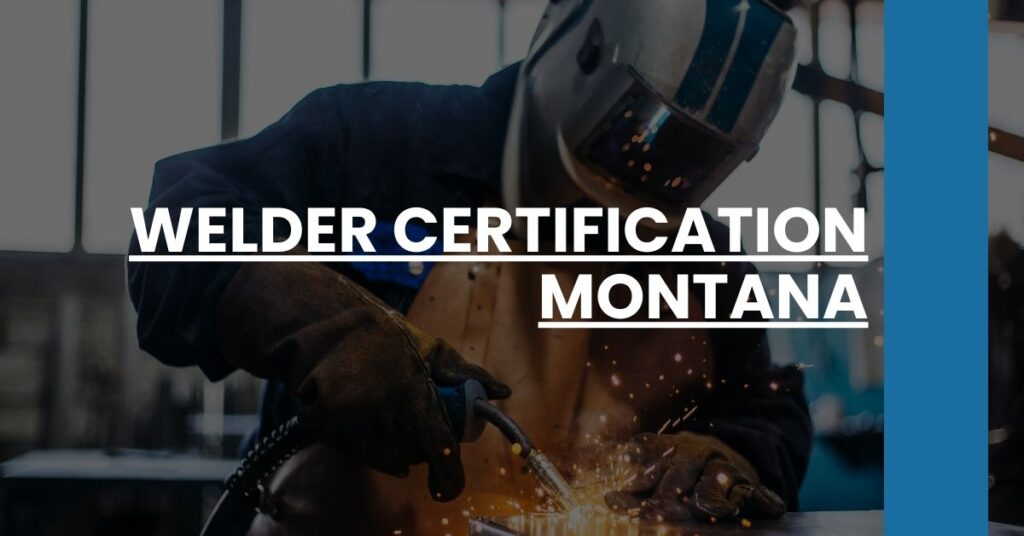Looking for schools in a specific city? Check out our lists of Welder Schools in Billings and Missoula.
Starting your journey to obtaining a Welder Certification Montana can feel overwhelming. I’ve been there, and I know the questions that can arise — What are the requirements? How do you apply? What training programs are available?
To help you navigate this path more smoothly, our team has put together a comprehensive guide that covers everything you need to know. This article will delve into:
- The specific requirements for welder certification in Montana.
- A step-by-step guide to the application process.
- An overview of the top training programs in the state.
- What Are the Requirements for Welder Certification in Montana?
- How to Apply for Welder Certification in Montana?
- What Training Programs Are Available in Montana?
- What to Expect During the Certification Exam?
- What Are the Costs Associated with Welder Certification?
- Benefits of Obtaining Welder Certification in Montana
- How to Maintain and Renew Your Welder Certification
- How to Become a Welder
- Looking for Welder Information On States Bordering Montana?
- Conclusion
What Are the Requirements for Welder Certification in Montana?
To embark on your journey to becoming a certified welder in Montana, understanding the initial requirements is crucial. While the state of Montana does not mandate any specific licensure or certification to work as a welder, obtaining professional certification can significantly enhance your job prospects and credibility in the welding industry.
Educational Background
A high school diploma or a General Educational Development (GED) certificate is generally the minimum educational requirement. These credentials demonstrate your ability to comprehend basic educational concepts, which forms a solid foundation for mastering more complex welding techniques.
Preliminary Courses and Training
Although not compulsory, enrolling in welding courses can significantly prepare you for certification:
- Drafting and CAD Design: These courses teach you how to interpret blueprints and design structures.
- Introductory Welding Courses: Cover the basics of various welding techniques, such as Shielded Metal Arc Welding (SMAW) and Gas Metal Arc Welding (GMAW).
Montana Career Pathway offers specialized welding and fabrication courses designed to help you acquire essential skills.
Age Requirements
Most welding programs and employers prefer candidates who are at least 18 years old. This age requirement ensures that students and employees are mature enough to handle welding equipment safely and responsibly.
By fulfilling these prerequisites, you set a strong foundation for obtaining your welder certification in Montana.
How to Apply for Welder Certification in Montana?
Applying for welder certification in Montana involves a systematic approach. Follow these steps to streamline this process.
Develop Welding Skills
Before you apply for certification, it’s advisable to:
- Enroll in a Welding Program: Choose a recognized institution like Great Falls College, which offers comprehensive training programs.
- Gain Practical Experience: Participate in internships or part-time jobs to hone your skills.
Choose a Certification Body
Montana does not have a state-specific certification; thus, opt for certifications from recognized organizations like:
- American Welding Society (AWS)
- Certified Welding Technologies (CWT)
Gather Necessary Documents
To apply, you’ll need:
- Proof of Educational Qualifications
- Training Completion Certificate (if applicable)
- Identification Documents (Driver’s License, Passport)
Submit Your Application
Visit the respective certification body’s website for application forms. Fill out the required details and attach the necessary documents. Pay the application fee, usually via online payment methods like credit cards or bank transfers.
Following these steps ensures that your application process is smooth and less time-consuming.
What Training Programs Are Available in Montana?
Montana offers a variety of training programs that cater to aspiring welders. These programs not only prepare you for certification exams but also equip you with vital skills for your career.
Helena College Mobile Welding Program
Helena College offers a unique mobile welding training program specifically tailored for inmates. The program includes:
- OSHA-10 Certification: This course ensures you understand workplace safety standards.
- Four-Week Course: Intensive hands-on training culminating in a Delta 1.1 welding certification.
Great Falls College
Great Falls College provides a comprehensive Career and Technical Education (CTE) program, covering multiple welding techniques:
- Shielded Metal Arc Welding (SMAW): Learn the basics of arc welding.
- Gas Metal Arc Welding (GMAW): Specialize in this versatile welding technique.
- Flux-Cored Arc Welding (FCAW): Master the skills needed for this semi-automatic process.
- Gas Tungsten Arc Welding (GTAW): Ideal for high-precision projects.
These programs prepare you for AWS certification exams and offer job placement assistance.
For a broader list of welding schools, visit Welding Schools.
If you’re curious about the best welding schools, check out Best Schools.
What to Expect During the Certification Exam?
Securing your welder certification involves passing a detailed examination process that evaluates both your theoretical knowledge and practical skills.
Exam Format
Certification exams, particularly those offered by AWS, generally follow a structured format:
- Written Test: This part assesses your understanding of welding principles and safety protocols.
- Practical Test: Here, you will demonstrate various welding techniques, focusing on the quality and accuracy of your welds.
Skills Assessed
During the practical test, you should be prepared to:
- Produce high-quality welds to meet industry standards.
- Demonstrate versatility in different welding techniques, including SMAW, GMAW, FCAW, and GTAW.
- Follow safety protocols meticulously to ensure safe welding practices.
Preparation Tips
- Enroll in preparatory courses: Like those offered by Great Falls College.
- Practice extensively: Use practice tests available online, such as the CWI Practice Test.
Understanding what to expect during the certification exam can significantly boost your confidence and help you perform better. Stay committed to your practice and preparation, and you’ll be well on your way to becoming a certified welder in Montana.
What Are the Costs Associated with Welder Certification?
When pursuing a career in welding, it’s essential to understand the financial investment involved in obtaining your welder certification in Montana. Here’s a breakdown of the various costs you should consider:
Tuition and Training Fees
Training programs can be one of the largest expenses. For instance, Great Falls College provides a comprehensive welding program. The estimated total cost for their welding program is approximately $10,023. This includes:
- Tuition and Fees: These can range based on residency status and specific courses taken.
- Course Fees: Additional fees for specialized welding courses.
- Books and Supplies: Textbooks and other necessary materials for the courses.
- Tools and Clothing: Essential welding tools and safety gear.
Exam Fees
Exam fees vary depending on the certification body. For example:
- AWS Certification: The American Welding Society typically charges an exam fee that can range from $300 to $500, depending on the specific certification you seek.
- ASNT MT Level I/II Certification: This certification’s course and exam cost around $499.
Additional Expenses
Beyond tuition and exam fees, expect additional costs such as:
- Study Materials: Investing in practice tests and study guides enhances your prep, like those found here: CWI Practice Test.
- Travel and Accommodation: If your training or exams are not local, factor in travel and lodging costs.
Understanding these costs helps you budget effectively and prepares you for the financial commitment of becoming a certified welder in Montana.
Benefits of Obtaining Welder Certification in Montana
Obtaining a welder certification can transform your career prospects in Montana. Here are some key benefits:
Higher Earning Potential
Certified welders often command higher salaries compared to their non-certified counterparts. In Montana:
- Hourly Wages: Certified welders can earn between $17.21 to $22.74 per hour.
- Annual Salaries: Specialized roles, like pipefitters, can earn up to $79,500 annually.
Enhanced Job Opportunities
Certification opens doors to a variety of industries and roles, including:
- Machinists: Engaging in the precise assembly of machinery.
- Tool and Die Makers: Crafting tools and dies for manufacturing.
- Equipment Operators: Operating heavy machinery in construction and manufacturing sectors.
Employers highly value certified welders for their proven skills and knowledge, making certified individuals more competitive in the job market.
Career Advancement
Certifications demonstrate your commitment to professional growth, positioning you for career advancement. As you gain experience and additional certifications, you can move into supervisory roles, specialized positions, and even start your own welding business.
How to Maintain and Renew Your Welder Certification
Maintaining your welder certification is crucial for career longevity. Follow these guidelines to keep your certification active and recognized:
Regular Renewals
Certain certifications, like those from AWS, require periodic renewals. AWS certifications, for example, need renewal every six months. To renew:
- Submit Proof of Work: Provide evidence that you’re actively engaged in welding.
- Adhere to Standards: Ensure your work meets industry standards.
Continuing Education
Engage in ongoing education to stay updated with industry advancements:
- Local Colleges and Institutes: Enroll in advanced welding techniques or new technology courses.
- Workshops and Seminars: Participate in industry-specific workshops and seminars.
Keeping Up with Certifications
Stay proactive in managing your certifications:
- Monitor Expiry Dates: Keep a calendar to track when renewals are due.
- Update Skills Regularly: Continuous engagement in welding tasks helps you remain proficient and compliant with renewal criteria.
By adhering to these practices, you ensure your certification remains active, keeping your skills current and marketable.
How to Become a Welder
If you’re considering a career in welding, there are some essential steps you’ll need to follow. Here’s a straightforward path to becoming a welder:
- Complete High School Education: Having a high school diploma or GED is generally required.
- Gain Welding Training: Enroll in a recognized welding school or technical college in Montana for foundational training.
- Obtain Certification: Sit for certification exams, such as those offered by AWS.
- Gain Work Experience: Accumulate practical experience through apprenticeships or entry-level jobs.
For more details, visit this guide on How to Become a Welder.
Looking for Welder Information On States Bordering Montana?
In addition to Montana, we suggest looking for schools in nearby states.
- Welder Certification Idaho
- Welder Certification Wyoming
- Welder Certification South Dakota
- Welder Certification North Dakota
- Welder Certification Minnesota
Conclusion
Welder certification in Montana offers a pathway to a rewarding and lucrative career. Following these guidelines equips you with the knowledge and tools to succeed in the welding industry. By investing in training, securing your certifications, and committing to continuous professional development, you can achieve your career goals and enjoy the many benefits that come with being a certified welder.

